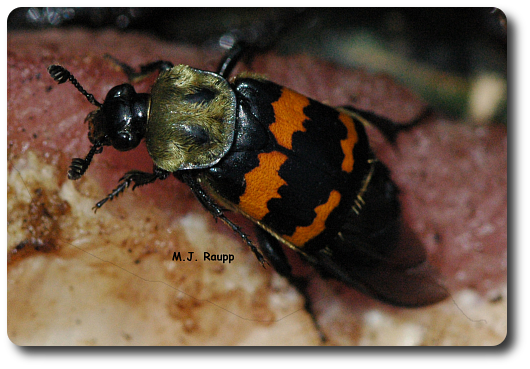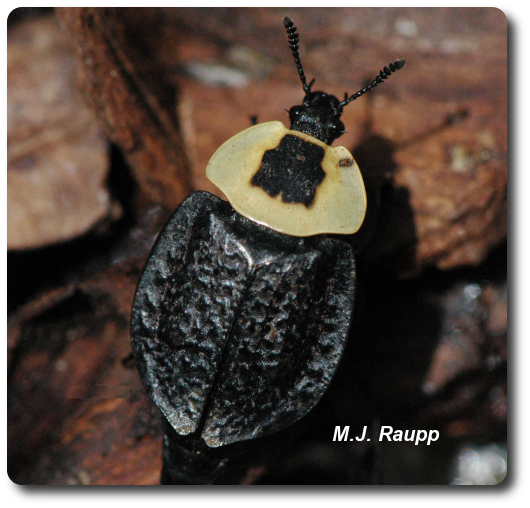A few weeks ago we visited Japanese beetles and discussed the use of pheromone baited traps to lure and capture them. Those who tried this routine, but were less than punctual emptying the bag as it filled with beetles, were probably treated to an interesting and malodorous concoction of rotting insects when at last the bag was opened. One of the gruesome benefits of accumulating massive quantities of smelly dead things is attracting a horde of insects that eat dead things. Among the more interesting of these are the burying beetles. Burying beetles lead lives that CSI Gil Grisham would envy. Using highly sensitive antennae loaded with chemical detectors, burying beetles locate dead animals in the forest, along roadways, or in Japanese beetle traps.
This unidentified Nicrophorus species could not resist the smell of dead things in the Japanese beetle trap.
Several of the beetles in this Bug of the Week were removed from Japanese beetle traps but two specimens were discovered attempting to bury a small mouse that had been killed along a woodland trail. After locating a small mammal or bird, a stalwart male and female couple will drive away potential competitors and cooperate in excavating the earth beneath the victim until is disappears below the ground. They seal the crypt from the outside world, remove the hair or feathers from the victim, and shape the mass of flesh into a compact ball. Within this crypt the female lays eggs on the soil. Small larvae hatch and the male and female cooperate in feeding the young. Larvae are fed liquefied food regurgitated from the mouth of their mother and father much the same way birds feed their young nestlings. Yum! The animal ball is tended by the adult beetle and secretions from the adult apparently keep unwanted fungi and bacteria from spoiling this remarkable food reserve. The mother excavates a shallow chamber in the ball of meat and, as larvae grow, they move into the chamber. Here they will continue to feed on parental delights and, eventually, the putrefying remains of the animal. They feed and grow until nothing is left but the bones. The adults adjust the size of the brood by eating some of their young, if the carrion is insufficient to support the growth of all of the youngsters.
The American carrion beetle emits an awful smell from its rear end when frightened.
When the larvae begin to pupate, the work of the adults is complete and the happy couple leave the nest to find other fresh cadavers. Two species of black and orange burying beetles, Nicrophorus tomentosus and an unidentified Nicrophorus were captured in our Japanese beetle traps. A third member of the silphid clan paid a visit to another trap. This was the American carrion beetle, Necrophila americana. When I plucked this beetle from the bag, I was treated to a sickening aroma. Adult American carrion beetles have specialized glands in their rectum that emit nasty defense compounds when the beetles are threatened. The lesson here is not to threaten them. American carrion beetles do not actively bury dead things. Instead, they eat the host of fly maggots hatched from eggs deposited on the carcass by blowflies. Larvae of the American carrion beetle receive no special parental care, but feed in and under the carcass. One species of burying beetle, Nicrophorus americanus, is found only in six states, Arkansas, Kansas, Nebraska, Oklahoma, Rhode Island, and South Dakota. It is considered an endangered species. To view this magnificent creature visit the following website http://unsm-ento.unl.edu/endanger.htm. If you find one of these in your Japanese beetle trap, contact your local Cooperative Extension Office or take a photograph and send it to Bug of the Week. It may be a new state record. Also, be sure to release it unharmed so it can continue its role in the circle of life and death.
References
Special thanks to Ellery Vodraska for helping collect burying and carrion beetles used in this Bug of the Week. The wonderful book "The Insect Societies" by E.O. Wilson and the websites below were used as references for this Bug of the Week.
https://bugguide.net/index.php?q=search&keys=carrion+beetles
https://www.springer.com/us/search?page=2&query=carrion+beetles&submit=Submit


